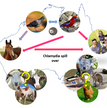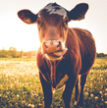- Diseases - veterinary ×
-
One C. psittaci clone to rule them all?
October 24, 2022
Upon the publication of her team's latest paper in Microbial Genomics, Dr Martina Jelocnik gives a behind-the-scenes look at the work of the University of the Sunshine Coast's Chlamydians team, keeping track of veterinary chlamydial infections.
-
Microbe Talk: MicroNews July
July 26, 2019
This is the first episode of MicroNews, where we discuss the times microbiology and microbiologists have been on TV, in the papers and trending online. This month, Laura and Matt talk about the HPV vaccine, fungal diseases and antimicrobial resistance. We also hear from Professor Sally Bloomfield who talks about the link between allergies and hygiene.
-
Investigating Lyme disease on the South Downs
April 6, 2017
The South Downs National Park is an area that stretches for 140 km along the South Coast of England, and is home to a huge diversity of plants and animals.
-
On the Horizon: Hantaviruses
October 18, 2016
In early 2013, a man in North Wales was rushed to hospital showing symptoms of serious kidney problems. The source of his infection? His pet rats.
-
EEHV: Herpes infection often fatal to baby elephants
June 11, 2015
It has been estimated that a staggering 90 per cent of the humans on Earth are infected with one or more viruses from the family Herpesviridae, which are commonly known as herpes viruses.
-
Schmallenberg in sheep, a variable virus
May 14, 2013
In 2011, a new animal virus was detected in the German town of Schmallenberg. This virus, which infects sheep and cows, is now sweeping across Europe and was first identified in the UK in 2012. In a new paper published in the Journal of General Virology, researchers in Belgium have found an area of the virus’s genome that is very prone to mutation.
-
New techniques detect BSE in extra-neuronal tissue of cattle
October 24, 2012
Bovine spongiform encephalopathy (BSE) or “Mad Cow Disease,” as it is more publicly known is a transmissible neurodegenerative disease affecting cattle. Importantly, it is also transmissible to humans and there is currently no treatment available. Scientists around the globe are working to better understand the infectious agent that causes the condition – a misfolded prion protein (PrPSc). In a new study, published in the Journal of General Virology, scientists used an improved detection technique to detect PrPSc in peripheral tissue from affected cattle. The findings suggest revised guidelines are needed on material banned from meat destined for animal feed or human consumption. This could help efforts to eradicate this disease.
-
The evolution of a diarrhoeal viral genome
September 19, 2012
Two billion cases of severe diarrhoea occur globally each year, representing the second leading cause of death in children under five years old, according to the World Health Organization. Diarrhoeal disease is both preventable and treatable. Devastating epidemics, outbreaks and sporadic cases of severe diarrhoea can be caused by the group B rotaviruses (RVBs). Using genomic sequencing, researchers have uncovered the evolutionary origins and diversity of human RVBs which will allow better diagnostic and disease prevention strategies to be developed.








